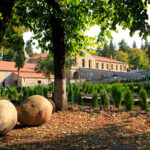
Santorini, Majorca, Capri, Mykonos, Corsica are just some of the picturesque islands in the Mediterranean Sea, and vineyards grow on almost every one. And the wines from the Mediterranean’s two largest islands, Sicily and Sardinia, are especially worth seeking out. Both of these Italian islands changed hands multiple times throughout history resulting in their distinct cultures, eclectic cuisines, and the planting of a few non-native grapes.

The critics love Sicilian wine lately. After decades of churning out bad house plonk, the island’s reds are often the first answer when you ask a sommelier about the next hot thing. Producers looking for change turned to Sicily’s indigenous grapes—namely Nerello Mascalese, Nero d’Avola, and Frappato (di Vittoria)—and honestly altered the course of Sicily’s wine history. Nerello Mascalese is closely associated with the wines being produced around the restless Mount Etna, in the western part of Sicily. Growing in volcanic soil does come through in the bottle, you’ll often find earthy or smoky notes, plus some minerality. They have the classic darker red fruit flavors of cherry and berries, with savory winter spice tinges. But what is shocking when presented with the ruby red wine is its thinness and the presence of more acidity than tannins. It’s great with pork, oily fishes, tomato-based dishes, eggplant, capers, and trendy shakshuka, but it’s also very good on its own.

Nerello Mascalese’s (not Nerello Cappuccio) rise in popularity may knock Nero d’Avola, “The Black Grape of Avola,” off its pedestal as Sicily’s most important grape. However, if you’re looking for something heavier than an Etna Rosso, Nero d’Avola is where you should turn. It lends itself to deeper, richer wine with floral, dark fruit, and licorice notes, but still easy on the tannins. These are the kind of wines you want to drink in winter. The flavors of Nero d’Avola round out when blended with Frappato in Cerasuolo di Vittoria wines. It punches up the acidity while polishing out the earthiness.

And then there’s gorgeous Sardinia. Though it has native grapes, its most famous varietals come from elsewhere. There’s Vermentino for whites; Monica, Carignano, and Cannonau for reds; and all have a salty quality from the sea air. Since we’re in a red state of mind, let’s stay there. Cannonau is arguably Sardinia’s most famous. Some may even say that Cannonau’s high resveratrol content is one of the reasons behind Sardinia’s high population of centenarians. Genetically the same as Grenache/Garnacha, Cannonau’s been on the island for over six centuries developing its own earthy and herbal characteristics.
Carignano, aka Carignan or Cariñena, has been on the island for two millennia. It’s also a robust, full-bodied red that can easily stand in place for a Chianti, and deals well with being aged. Monica di Sardegna is the hardest to find—as are all Sardinian wines—but if you do get your hands on a bottle, you’ll be rewarded another full-bodied red. This one you have to enjoy while it’s still young. With such a small island, anything you find in the States is worth trying.


